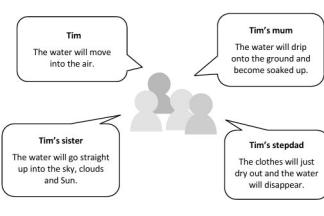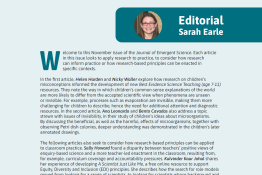Diagnostic assessment: The BEST way to discover what children are really thinking about materials
Issue 29 | Page 5 | Published Nov 2025
Description
Abstract
The Best Evidence Science Teaching (BEST) (7-11) ‘Materials and their properties’ resources have been developed by the Centre for Industry Education Collaboration (CIEC), funded by the Horners’ Charities. The resources bridge the gap between research on children’s misconceptions in science and classroom practice through the creation of a suite of classroom resources to support effective formative assessment and the development of secure understanding about materials and their properties. The resources are generic and therefore support not only teaching and learning in England, but also across the UK and internationally. This article explores in more depth how research informed the creation of key components of the resources, namely the learning progressions, diagnostic questions and response activities. It draws together thinking from the research reading across the topic of materials and their properties, including states of matter, the water cycle, separating and changing materials, to identify common patterns in children’s misconceptions about materials and their properties leading to a discussion of the potential implications for classroom practice. Finally, the article suggests areas for further research reading and resource development.
References
Abrahams, I. & Millar, R. (2008) ‘Does practical work really work? A study of the effectiveness of practical work as a teaching and learning method in science’, International Journal of Science Education, 30, (14), 1945–1969
Blosser, P.E. (1987) ‘Science misconceptions research and some implications for the teaching of science to elementary students’, ERIC/SMEAC Science Education Digest No. 1. https://eric.ed.gov/?id=ED282776
Duschl, R., Maeng, S. & Sezen, A. (2011) ‘Learning progressions and teaching sequences: A review and analysis’, Studies in Science Education, 47, (2), 123–182 [Online]. Available at: doi:10.1080/03057267.2011.604476
Henriques, L. (2002) ‘Children’s Ideas About Weather: A Review of the Literature’, School Science and Mathematics, 102, (5), 202–215 [Online]. Available at: doi:10.1111/j.1949-8594.2002.tb18143.x
Kikas, E. (2001) ‘Children’s Understanding of Dissolving: The Influence of Visibility of the Process. Implications for Teaching’, Science and Technology Education: Preparing Future Citizens. Proceedings of the IOSTE Symposium in Southern Europe. https://eric.ed.gov/?id=ED466376
Krnel, D., Glažar, S.A. & Watson, R. (1998) ‘Survey of research related to the development of the concept of “matter”’, International Journal of Science Education, 20, (3), 257–289 [Online]. Available at: doi:10.1080/0950069980200302
Pilatou, V. & Stavridou, H. (2004) ‘How primary school students understand mains electricity and its distribution’, International Journal of Science Education, 26, (6), 697–715 [Online]. Available at: doi:10.1080/0950069032000119447
Rahayu, S. & Tytler, R. (1999) ‘Progression in Primary School Children’s Conceptions of Burning: Toward an Understanding of the Concept of Substance’, Research in Science Education, 29, (3), 295–312
Smolleck, L. & Hershberger, V. (2011) ‘Playing with Science: An Investigation of Young Children’s Science Conceptions and Misconceptions’, Current Issues in Education, 14, (1), 1–31 [Online]. Available at: http://cie.asu.edu/ojs/index.php/cieatasu/article/view/
Stachel, D. & Stavy, R. (1986) ‘The effect of teaching on the understanding of the concepts “solid” and “liquid” by kindergarten children’. https://eric.ed.gov/id=ED291557
Talanquer, V. (2006) ‘Commonsense chemistry: A model for understanding students’ alternative conceptions’, Journal of Chemical Education, 83, (5), 811–816
Teixeira, F. (2000) ‘What happens to the food we eat? Children’s conceptions of the structure and function of the digestive system’, International Journal of Science Education, 22, (5), 507–520 [Online]. Available at: doi:10.1080/095006900289750
More from this issue
Abstract
Microorganisms are almost ubiquitous, but their small size often makes them difficult for children to...




